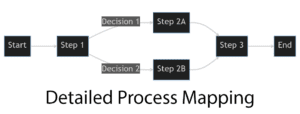Navigating through the vast sea of Six Sigma, there’s one beacon that never fails to guide the journey – Measurement System Analysis (MSA). Let’s get started with this beginner-friendly guide, introducing you to the ins and outs of MSA in Six Sigma.
- A. Unravelling the Concept of Measurement System Analysis (MSA)
- B. The Power of Measurement System Analysis in Six Sigma and DMAIC
- C. The M&M Example: An Appetizing Introduction to Measurement System Analysis
- II. The Principles of Measurement System Analysis
- III. The Role of Measurement System Analysis in Different DMAIC Phases
- IV. The Need for Measurement System Analysis
- V. Fundamentals of Accurate Measurement System Analysis
- VI. The Process and Importance of Calibration in Measurement System Analysis
- VII. Understanding Measurement Error in Measurement System Analysis
- VIII. Frequently Asked Questions (FAQs)
- IX. Conclusion
A. Unravelling the Concept of Measurement System Analysis (MSA)
In simple terms, Measurement System Analysis (MSA) is a scientific method used to identify the amount of error or variation in the measurement process. Consider MSA as the quality control for your measurement process. In Six Sigma, a methodology aimed at reducing variation and improving processes, the accuracy of measurement is a cornerstone. If we can’t trust our measurements, we can’t make informed decisions, and that’s where MSA comes in.
B. The Power of Measurement System Analysis in Six Sigma and DMAIC
MSA stands tall in the DMAIC (Define, Measure, Analyse, Improve, and Control) process – the very heart of Six Sigma. It’s during the Measure phase that MSA flexes its muscles, ensuring data collected is both accurate and reliable. But its role doesn’t end there; MSA plays a significant part in the Analyse, Improve, and Control phases too, as we’ll discuss in detail later.
In essence, MSA offers us a way to dissect and understand the inherent variation in our measurements. It answers questions like, “Can we trust our data? Is it consistent? Is it accurate?” With MSA, we can make data-backed decisions with confidence.
C. The M&M Example: An Appetizing Introduction to Measurement System Analysis
To illustrate this concept, let’s use an M&M example. Imagine you’re tasked with quantifying how many cups of M&Ms are produced in a single run. You use a not-so-accurate measuring cup while your colleague employs a highly precise instrument. The result? Two different measurements.
In this scenario, the accumulated variation between your two measuring cups demonstrates Measurement Variation, a concept central to MSA. The error isn’t with the M&Ms themselves, but with how they’re being measured – a common issue that MSA seeks to address.
In our upcoming sections, we’ll take a deeper dive into the principles of MSA, its role in the different phases of DMAIC, and more. Stay tuned, as we explore the world of precision in Six Sigma, one M&M at a time!
II. The Principles of Measurement System Analysis

Understanding MSA requires a grasp of two key concepts: Measurement Data and Measurement Variation. Let’s break down these principles one by one and continue with our delicious M&M example.
A. The Nuts and Bolts of Measurement Data and Measurement Variation
Measurement data, as the name suggests, pertains to the information obtained through measurement. In our M&M example, this would be the number of cups of M&Ms we collect from each run. Measurement Variation, on the other hand, refers to the variation in the measurements taken. If you measure the same quantity multiple times, you may get slightly different results each time. This discrepancy is the Measurement Variation.
Remember, in Six Sigma, we’re always chasing precision and consistency. Therefore, understanding and managing Measurement Variation is vital to maintain the accuracy of data.
B. The Equation That Brings It All Together
In MSA, a fundamental equation to remember is: Total Variation = Process Variation + Measurement Variation.
Process Variation refers to the natural and inevitable fluctuations that occur in any process. Let’s consider the M&M production line. There may be minor differences in the number of M&Ms produced in each run – that’s Process Variation.
Measurement Variation, as we discussed, arises from the measurements taken.
Hence, the Total Variation you observe in the process combines both these sources. MSA aims to distinguish and minimize the Measurement Variation to get a clearer picture of the actual Process Variation.
C. Delving Deeper into the M&M Example
Suppose you and your colleague measure the quantity of M&Ms in a production run. However, your measuring cup isn’t as accurate as your colleague’s device. When you compare the measurements, there’s a variation, right? This disparity is a prime example of Measurement Variation.
If the Measurement Variation is high, it muddies our understanding of the Process Variation. In our M&M example, this could lead to incorrect estimations of the M&M production. And in the world of Six Sigma, inaccurate data is a no-go!
That wraps up our exploration of MSA’s principles. We’ve used our M&M example to bring these concepts to life. As we move forward, we’ll examine how MSA operates in different phases of the DMAIC process. So, grab your measuring cup, and let’s march on to a world of precise data!
III. The Role of Measurement System Analysis in Different DMAIC Phases
Having explored the fundamental principles of MSA, it’s time we dive into its role in the DMAIC (Define, Measure, Analyse, Improve, Control) phases of Six Sigma.

A. Measure Phase: Ensuring accurate and consistent data collection
Let’s start with the Measure phase. It’s all about gathering data relevant to the current process and based on the project Y. Here, MSA becomes an indispensable tool to ensure that the data collected is accurate and consistent. It helps you validate the reliability of your measurement system before collecting and analysing a substantial amount of data. Think about it – inaccurate measurements during this phase can lead you down the wrong path!
B. Improve Phase: The necessity of precise and accurate data
Next, we come to the Improve phase, where you design creative solutions to eliminate the root causes of issues. It’s here that MSA’s importance shines again. After all, we can only make meaningful improvements if our data – the backbone of our strategies – is trustworthy. MSA gives us this assurance, supporting us in developing precise and impactful improvements.
C. Control Phase: Use of measurements for statistical process control and visualizing process control
Finally, during the Control phase, where you monitor and control the improved process, MSA again steps into the spotlight. The measurements you use for statistical process control and to visualize process performance need to be reliable. MSA makes sure of this. It ensures that you continue to produce high-quality results over time.
From these insights, it’s clear that MSA isn’t just a one-and-done process. It’s a continuous practice that spans across all phases of DMAIC, ensuring data accuracy and aiding in decision-making. Up next, we’ll focus on why MSA is so critical in the realm of Six Sigma. Stay tuned!
IV. The Need for Measurement System Analysis
Understanding why we need MSA will give you an even clearer picture of its role in Six Sigma. Let’s delve into how MSA gauges the quality of a measurement system and its importance in decision-making and quality management systems.
A. Exploring How Measurement System Analysis Gauges the Quality of a Measurement System
One of the primary reasons we need MSA is to ensure that our measurement system itself is of high quality. You may have a state-of-the-art process, but if your measurements are off, your data will mislead rather than inform. MSA, with its techniques to identify and minimize Measurement Variation, helps validate the quality of your measurement system, leading to trustworthy data.
B. Importance of Data Accuracy in DMAIC Process and Decision Making
As you’ve seen in the previous sections, data accuracy is paramount in the DMAIC process. Every phase, from Measure to Control, relies heavily on accurate data. Poor data quality can lead to misdirected efforts, wasted resources, and flawed decision making. MSA, in ensuring data accuracy, helps us avoid these pitfalls.
V. Fundamentals of Accurate Measurement System Analysis
Having established why we need MSA, let’s now delve into the fundamentals that ensure its accuracy. From defining Accuracy, Precision, and Stability to understanding Bias, Linearity, and Repeatability, this section is all about the building blocks of MSA.
A. Defining Accuracy, Precision, and Stability in Measurement System Analysis
In the MSA world, accuracy refers to how close a measurement is to the true value. Precision, on the other hand, is about the consistency of your measurement. If you can hit the same spot repeatedly but that spot is far from the target, you’re precise but not accurate. If you hit the target once but can’t replicate it, you’re accurate but not precise. MSA aims for both: hitting the target consistently.
Stability refers to the consistency of measurements over time. It ensures that the performance of the measurement system remains unchanged over prolonged periods.
B. Explaining Bias, Linearity, Stability, and Repeatability
Bias is the difference between the average measurement and the true value. It tells us how far off our measurements tend to be from the actual value.
Linearity assesses how accurate your measurements are across the entire range of measurement. A system is linear if it provides equally accurate measurements regardless of the measured value’s size.
Stability, as we discussed, measures the consistency of measurements over time.
Repeatability assesses the variation in measurements taken by one person or instrument on the same item and under the same conditions. A system with high repeatability consistently provides the same results.
Understanding these concepts is crucial to ensuring that your MSA is both accurate and reliable. Next, we’ll dig into the process and importance of Calibration in MSA – another crucial component in the quest for precise data in Six Sigma. Stay with us!
VI. The Process and Importance of Calibration in Measurement System Analysis
Calibration is a critical process in MSA. It’s akin to tuning an instrument before a performance – we must make sure our measurement devices are hitting the right notes!
A. Definition and Explanation of Calibration
Calibration is the process of adjusting a measurement device to ensure its readings are accurate. It involves comparing the readings of the instrument to a known standard. Any deviation from this standard indicates that the device needs adjustment.
B. Role of Calibration Standards at Different Levels: In-house, National, International
Calibration standards come in various forms: in-house, national, and international. An in-house standard is specific to an organization, while national and international standards follow country-wide or global norms.
Your measurement device may need to comply with a variety of standards, depending on its use. For instance, a device used for in-house testing might only need to meet your company’s in-house standard. However, if the device’s readings have legal or regulatory implications, it might need to comply with national or international standards.
C. Importance of Calibration Intervals, and Principles of Calibration
Regular calibration is essential for ensuring consistent, accurate measurements. Calibration intervals – the time between calibrations – depend on the instrument’s use, the importance of its measurements, and its tendency to drift from true readings.
The primary principle of calibration is that it must be traceable. That means there should be an unbroken chain of comparisons, each linking to a recognized standard, ensuring the accuracy of the calibration.
As you can see, Calibration is a crucial step in ensuring accurate and reliable measurements in Six Sigma projects. Let’s continue our journey into MSA by understanding Measurement Error next. Stick with us!
VII. Understanding Measurement Error in Measurement System Analysis
No matter how precise we aim to be, every measurement system has a margin of error. The key is to understand, quantify, and minimize it.
A. Definition of Measurement Error
Measurement Error is the difference between the actual (true) value and the measured value. In essence, it’s the discrepancy that can occur each time a measurement is made. Understanding Measurement Error is essential in evaluating the reliability of your data.
B. Factors Affecting Measurement Error: Instrument Used and the Person Using the Instrument
Several factors contribute to Measurement Error. Two of the most significant are the instrument used and the person using the instrument.
An instrument can introduce error if it’s not calibrated correctly, if it’s of poor quality, or if it’s simply inappropriate for the measurement being taken. For instance, using a standard ruler to measure a microchip’s thickness won’t give you a precise result.
The person using the instrument can also be a source of error. Even the best instrument can give inaccurate results if used incorrectly. Inadequate training or careless handling of the instrument can lead to significant Measurement Error.
By understanding and managing Measurement Error, you can ensure the accuracy and reliability of your data. This, in turn, leads to more effective decision-making and improved outcomes in your Six Sigma projects. Let’s move to the FAQs next – get ready to debunk some common queries about MSA!
VIII. Frequently Asked Questions (FAQs)
Now let’s address some common questions that arise around MSA in the context of Six Sigma.
A. What is Measurement Systems Analysis (MSA)?
Measurement Systems Analysis (MSA) is a scientific method used in Six Sigma to assess the quality of data collected for process improvement. It focuses on identifying and reducing errors in measurement to ensure the data’s accuracy, reliability, and consistency.
B. Why is Measurement System Analysis important in Six Sigma and DMAIC?
MSA is crucial in Six Sigma and DMAIC because decisions in these processes heavily rely on data. MSA ensures that this data is accurate, consistent, and trustworthy, thus leading to effective decision-making and successful process improvement initiatives.
C. What is the role of calibration in Measurement System Analysis?
Calibration plays a vital role in MSA. It adjusts measurement instruments to ensure their readings are accurate. Regular calibration reduces the risk of Measurement Error, thus enhancing the quality of data used in Six Sigma projects.
D. What are some common sources of measurement error in Measurement System Analysis?
Common sources of Measurement Error include the instrument used and the person using the instrument. An improperly calibrated, poor-quality, or inappropriate instrument can introduce error. Similarly, an operator with inadequate training or a careless attitude can also cause errors.
E. How does Measurement System Analysis ensure data accuracy in the DMAIC process?
MSA ensures data accuracy in the DMAIC process by assessing the quality of the measurement system. It identifies and reduces Measurement Variation, thereby improving the precision and reliability of data used for decision-making.
F. What does the M&M example demonstrate about measurement variation?
The M&M example demonstrates that different measurement systems may introduce variability, known as Measurement Variation. In this example, an inaccurate measuring cup may result in different quantities of M&M compared to a precise device, illustrating the impact of Measurement Variation on data accuracy.
Hopefully, this FAQ section has cleared some of your doubts about MSA. In the next part, we’ll wrap up our discussion and recap the value of MSA in Six Sigma and DMAIC. Stick around for the conclusion!
IX. Conclusion
In our exploration of Measurement Systems Analysis (MSA), we’ve seen its central role in the Six Sigma methodology and DMAIC process.
A. Recap of the Importance and Role of Measurement System Analysis in Six Sigma and DMAIC
MSA is a crucial tool for assessing the quality of a measurement system. It’s a guardian of data accuracy, ensuring that your Six Sigma projects are based on reliable, consistent, and trustworthy data. From identifying sources of Measurement Variation to ensuring precise calibration, MSA helps ensure the data used in every DMAIC phase is up to the mark.
B. Reinforcing the Value of Measurement System Analysis with the M&M Example
Our M&M example brought to light the concept of Measurement Variation. It showed us that even something as simple as measuring cups of M&M’s can introduce variation, highlighting the importance of an accurate measurement system.
Remember, quality isn’t just a destination; it’s a journey, and MSA is an invaluable companion on that journey. It’s your key to unlocking a world of data-driven decision-making and continual process improvement in Six Sigma.
I hope this article helped you understand the importance of MSA in the context of Six Sigma and DMAIC.
Stay tuned for our next article, where we delve into another fascinating aspect of Six Sigma. Until then, happy improving!








